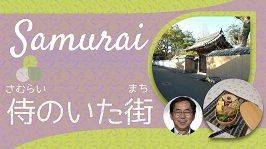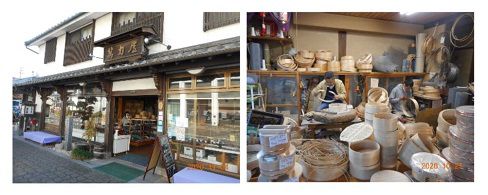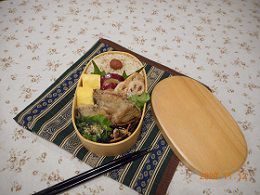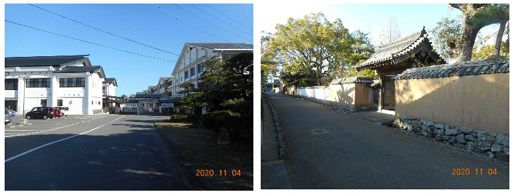
Japan's historic castle towns
Japan is a land with a fascinating history. One of the most interesting segments of history is the eras in which castles were constructed. Many of these remain in part or have been reconstructed and many historic castle towns are extremely well preserved.
In this blog for Japanese learners, Japanese teacher Hiroshi Yamamoto used to live in one of these towns. Listen to Yamamoto sensei explain what life is like there and look at the wonderful photos to get a sense of the place.
侍のいた町
A town with Samurai

By YAMAMOTO Hiroshi
私は以前、隣町の杵築市という所に住んでいました。そこはお城のある城下町で、約150年前まで侍や職人がたくさん暮らしていました。今でもその時の風景や技がそのまま残っています。今日はそれを少し紹介します。
最初は、職人の住んでいた通です。今でも当時の建物で商売をしている「あやべ味噌屋」 や、木製品を作っている「萬力屋」があります。「萬力屋」では、シュウマイなどを蒸す時に使うせいろうなどを作っています。商品は全て昔からの伝統的な方法で手作をしています。70歳のお父さんとその息子さんが毎日店の中で座って作業をしています。それらは一枚の薄い板をきれいに丸く曲げて、接着材や釘なども使わず組み立てています。

私は、以前このお店でヒノキでできたお弁当箱を買いました。会社に勤めていた頃、毎日このお弁当箱を使っていました。とてもデザインがシンプルで気にいっています。ヒノキは抗菌作用もあり、ご飯もおいしくなるそうです。昔の人々が使っていたものと同じ物を、今でも使えることは、嬉しいことです。

次に、侍が住んでいた通りです。その通りの中に今、小学校や幼稚園があります。そこは、侍の子供の学校である藩校があった場所です。私の娘たちも通っていました。今その学校の建物はコンクリート製ですがお城のようなデザインです。塀は当時の物をそのまま残して、藩校の門もそのままあります。今も子供たちはそこを通学に使っています。この通りを歩くと、侍が角から出て来そうな気がします。昔使っていた空間が、今でも大切に残されて、それを使っていることはすばらしいと思います。

他にもここでは昔の風景の中でたくさんの日常生活が行われています。この城下町は、今でもぶらりと立ち寄ると、私をいつも癒してくれる大切な場所です。
To listen to this blog, please watch our Youtube video.
侍(さむらい)のいた町(まち)
私は以前(いぜん)、隣町(となりまち)の杵築市(きつきし)という所(ところ)に住(す)んでいました。そこはお城(しろ)のある城下町(じょうかまち)で、約(やく)150年前まで侍(さむらい)や職人(しょくにん)がたくさん暮(く)らしていました。今でもその時の風景(ふうけい)や技(わざ)がそのまま残(のこ)っています。今日はそれを少(すこ)し紹介(しょうかい)します。
最初(さいしょ)は、職人の住んでいた通(とお)りです。今でも当時(とうじ)の建物(たてもの)で商売(しょうばい)をしている「あやべ味噌屋(みそや)」 や、木製品(もくせいひん)を作っている「萬力屋(まんりきや)」 があります。「萬力屋」では、シュウマイなどを蒸(む)す時に使うせいろうなどを作っています。商品(しょうひん)は全(すべ)て昔からの伝統的(でんとうてき)な方法(ほうほう)で手作(てづくり)をしています。70歳(さい)のお父さんとその息子さんが毎日店の中で座(すわ)って作業(さぎょう)をしています。それらは一枚(いちまい)の薄(うす)い板(いた)をきれいに丸(まる)く曲(ま)げて、接着材(さっちゃくざい)や釘(くぎ)なども使わず組(く)み立(た)てています。
私は、以前(いぜん)このお店でヒノキでできたお弁当箱(べんとうばこ)を買(か)いました。会社(かいしゃ)に勤(つと)めていた頃(ころ)、毎日このお弁当箱を使っていました。とてもデザインがシンプルで気にいっています。ヒノキは抗菌作用(こうきんさよう)もあり、ご飯(はん)もおいしくなるそうです。昔の人々が使っていたものと同じ物を、今でも使えることは、嬉(うれ)しいことです。
次に、侍(さむらい)が住(す)んでいた通りです。その通りの中に今、小学校(しょうがっこう)や幼稚園(ようちえん)があります。そこは、侍の子供(こども)の学校である藩校(はんこう)があった場所(ばしょ)です。私の娘(むすめ)たちも通(かよ)っていました。今その学校の建物(たてもの)はコンクリート製(せい)ですがお城のようなデザインです。塀(へい)は当時の物をそのまま残(のこ)して、藩校の門(もん)もそのままあります。今も子供たちはそこを通学(つうがく)に使っています。この通りを歩くと、侍が角(かど)から出て来そうな気がします。昔使っていた空間(くうかん)が、今でも大切(たいせつ)に残されて、それを使っていることはすばらしいと思います。
他(ほか)にもここでは昔の風景(ふうけい)の中でたくさんの日常生活(にちじょうせいかつ)が行われています。この城下町は、今でもぶらりと立(た)ち寄(よ)ると、私をいつも癒(いや)してくれる大切(たいせつ)な場所(ばしょ)です。
A town with Samurai
Before I used to live in the neighboring town of Kitsuki City. It’s a castle town with a castle, and roughly about 150 years ago many Samurai and craftsmen lived there. Even now the scenes and skills from those times still remain there today just as they did before. So I’d like to introduce these a little today.
First, there is the street on which the craftsmen lived. There are shops that still trade in the same buildings as they did in those times, like ‘Ayabe Miso’ and a shop that makes wooden products, called ‘Manrikiya’. ‘Manrikiya’ makes the wooden baskets that are used to steam Shumai dumplings. All of the products are hand-made using the same traditional methods from ancient times. A 70-year-old father and his son sit in the store all day working. They curve a piece of wood beautifully into a circle and create the works without using any glue or nails.
I once bought a lunchbox made from Cyprus wood from this store. When I was working at a company, I used this lunchbox every day. The design is really simple and I really like it. Cyprus has an antibacterial effect and it also makes the rice taste delicious. I feel glad to use the same products today in the same way as people did in ancient times.
Next, there is the street on which Samurai lived. On this road now there is an Elementary school and a Kindergarten. The site is one where a Han School, which was a school for Samurai children, once stood. My daughters went to this school. The school is now made of concrete but is designed like a castle. The wall is the same one as the one from those times and the old Han school’s gate still remains too. Children use it today when commuting to school. When walking down this street, I feel like a Samurai could just appear on the street corner. I think it is wonderful that some spaces that were used in ancient times have been dearly preserved today, and are still being used today.
There are a lot of other daily life activities being taking place here within the ancient atmosphere. It’s an important place for me, and when I stroll downtown in this castle town, I always feel healed.
以前(いぜん):before
隣町(となりまち):neighboring town
杵築市(きつきし):Kituki city
城(しろ):castle
城下町(じょうかまち):castle town
侍(さむらい):warrior (esp. of military retainers of daimyos in the Edo period); samurai
職人(しょくにん):craftsman;
風景(ふうけい):scene
技(わざ):skill
通(とお)り:street
商売(しょうばい):trade
あやべ:Ayabe
味噌(みそ):miso; fermented condiment usu. made from soybeans
屋(や):(something) shop
木製品(もくせいひん):wooden products
萬力屋(まんりきや):Mannrikiya
シュウマイ:Shumai
蒸(む)す:to steam
せいろう:steaming basket
伝統的(でんとうてき):traditional
手作(てづくり):handmade
曲(ま)げる:to curve
接着材(せっちゃくざい):adhesive
釘(くぎ):nail
組(く)み立(た)て:make up
ヒノキ:hinoki cypress
弁当箱(べんとうばこ):lunch box
勤(つと)める: to be employed (at)
シンプル:simple
抗菌作用(こうきんさよう):antibacterial effect
幼稚園(ようちえん):kindergarten
藩校(はんこう):Han schoolThe han school was an educational institution in the Edo
コンクリート製(せい):made of concrete
デザイン:design
塀(へい):wall
当時(とうじ):at that time
門(もん):gate
通学(つうがく):commuting to school
角(かど):(street) corner
雰囲気(ふんいき):atmosphere
すばらしい:wonderful
日常生活(にちじょうせいかつ): daily life
ぶらりと:stroll out
立(た)ち寄(よ)る:to stop by
癒(いや)す:to heal

Konnichiwa! My name is Hiroshi Yamamoto. I live in Oita in Kyushu with my family (my wife, daughter and an old female cat). Oita is famous for hot springs. I often visit hot springs in the winter.
My hobbies are gardening and watching soccer. When caring for my plants, I notice their daily changes and I feel relaxed. About soccer, I played soccer until about 20 years ago. But now I just watch the game.
I worked for a machine manufacturer for about 40 years. During that time, I worked in various departments including factory, trade, research and development, sales, general affairs, accounting, and auditing. I think I can help you to understand about business, industry and life in Japan from my experience.
What is your purpose of studying Japanese? Let’s make your dream come true by learning Japanese. I will do my best in our class to help you achieve your goals. Please knock on the classroom door at any time.


